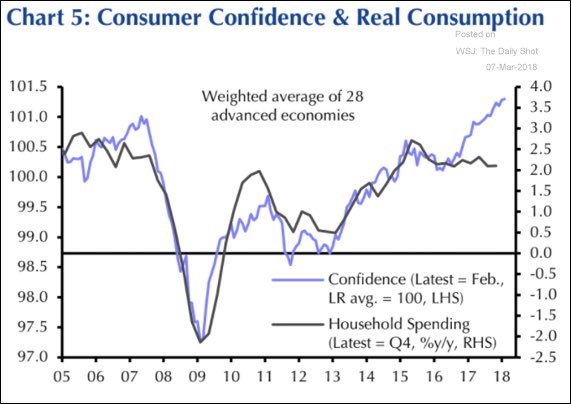Consumer Confidence Irrelevant
Many bearish investors have used the heightened consumer confidence reports to justify their negativity. They want to fade the optimism because when euphoria occurs, it’s usually followed by despair. I certainly agree with this mindset when it comes to the consumer’s opinion on the stock market over the next year. We saw stocks rally in record breaking fashion. That simply confirmed the euphoria consumers felt. It was easy to see why you should fade the consumer in that instance. However, when it comes to consumer confidence the bearish argument may be wrong.
As you can see from the chart below, the consumer confidence has increased dramatically while consumer spending growth has stagnated. The consumer confidence numbers have become politicized as there has been a record number of consumers, who when they are being polled, give unprovoked positive stats on the economy. Therefore, it makes sense to ignore the consumer confidence figure rather than fade it. If consumers aren’t accurately telling pollsters about their spending, then this data is useless.
The chart is enlightening because the divergence only started in the past 12 months. This is an example of an indicator losing its influence over time. There will never be a perfect indicator which will always tell you where stocks and the economy will go. It’s best to always be vigilant. We’re lucky to see this information because we now know not to be bearish on the medium term. We also shouldn’t expect consumer spending to perk up in the next few months based on the optimism. Obviously, the tax cut could help consumer spending, but just make sure not to cite confidence as justification for this thesis.

An Indicator Which Uses Consumer Confidence
It’s obvious that the data is skewed when you look at the consumer confidence polls. However, many economic metrics also use this indicator which means it’s hidden. The chart below shows Yardeni’s fundamental stock market indicator compared with the S&P 500. The indicator includes consumer sentiment. It also includes the jobless claims report which has become less useful than the past because it is at a record low on a population adjusted basis even though the labor market isn’t at full employment. To be clear, I’m not saying that the stock market shouldn’t go higher. I’m saying that this indicator is using flawed data. I actually agree with its prediction; I just disagree with its method.













Leave A Comment